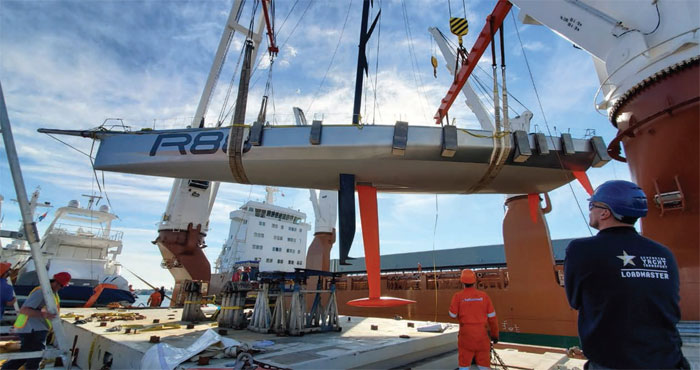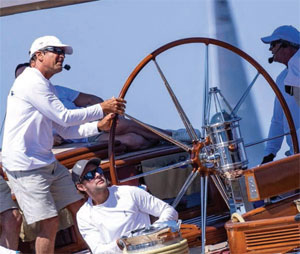

Whatever the precious cargo you are shipping between regattas or simply around the world, having a single point of contact taking care of every aspect of the delivery makes for a better night’s sleep
Shipping raceboats between events makes a lot of sense, whatever the size of the yacht. In particular, wear and tear is eliminated so you can expect the boat, sails and equipment to arrive in the same condition in which it left. It’s also possible to ship the yacht’s container or a trailer with equipment and spares, either at the same time or ahead of the boat.
Dutch company Sevenstar is arguably the biggest name in the field globally and has more than 120 of its own ships used for both scheduled and one-off sailings. The former includes a monthly schedule from northern Europe to the Baltimore region in the USA, plus three sailings a year from northern Europe to the Caribbean via Southampton, as well as return sailings from the Caribbean to the Mediterranean.
‘Having our own vessels means that we have plenty of regular sailings and reach all the racing destinations,’ says Sander Speet, who is in charge of race yacht logistics and is the central contact point for clients at every stage of the process. ‘If our regular timing or routing doesn’t work for a client we can always make a customised sailing. This might use another vessel from our own fleet or in an extreme example we can charter a ship to create a sailing with specific timings, plus loading and discharging ports that all meet the customer’s requirements.’
A racing team comprises many personnel from skippers to grinders, sail trimmers to shore managers. Speet’s background is as a professional offshore racing helm and trimmer, with three maxi world championship titles to his name. This gives him a solid grounding in the industry from a client’s perspective, when he was involved with loading and unloading race yachts from cargo vessels on a regular basis. This experience allows Sevenstar to become an integrated member of each racing team, from a logistics perspective.
Speet still spends 20 per cent of his time racing boats as diverse as Niklas Zennström’s new TP52 Ran and the J Class yachts Topaz and Svea. So how does this aspect of his work help him in his role at Sevenstar? ‘It's a big benefit because I’m right in the middle of the mix in the racing scene,’ he says. ‘It means you can get involved in the shipping process quite early on, making sure key people have the information they need at the right time and so on. After sailing I can keep tabs on everything back here in the office in Amsterdam, and benefit from direct face-to-face contact with all the other race crews. It's perfect for networking and collaboration.’
This element of Speet’s working life also enables Sevenstar to develop closer relationships with yacht clubs and race organisers. ‘That’s increasingly important for us,’ he says. ‘Talking to them at an early stage can bring a real benefit to both competitors and organisers – with enough notice we can schedule sailings to perfectly match the dates of a regatta. That then helps us to pick yachts up in good time to get them to their next event. We know race teams and owners often operate on tight schedules, without room for error, so it’s great if we can coordinate vessel timings efficiently around the dates of each event.’
Today there’s almost no size limit to the yachts that can be shipped. Transporting the largest racing yachts like Rambler and the Wally 165 Better Place is routine and it’s not unusual to see big motor boats and superyachts loaded on Sevenstar ships. The operations team for these is the same as for raceboats, so much larger sailing yachts than 100ft can be transported, even if they require very delicate handling.
Given any yacht – and especially a raceboat – will require more delicate handling than the cargo ports are accustomed to dealing with, the operation teams have robust procedures in place to ensure the process works smoothly. All Sevenstar’s loadmasters, for instance, are part of the company, even if the ship is chartered.
They are in charge of the process as soon as the yacht is alongside the ship, making sure that slings and protection are in the right place, that the boat balances safely when lifted by the crane, and so on. ‘As soon as the slings are lifting the yacht it becomes our commitment,’ says Speet. ‘It then stays that way until the moment the yacht touches the water at the destination and the slings are no longer in tension.’ Loadmasters also have the authority to pause loading or unloading if the wind strength reaches pre-set limits.
Before a yacht can be loaded, a lot of action takes place behind the scenes. ‘As we work on the booking we gather as much technical information and data from the owner as possible,’ Speet says. ‘Our operations team here in Amsterdam then analyses it and makes a detailed cradle, lifting and deck plan.’
Fortunately, it’s easy for raceboat owners to supply the basic data needed to get an indicative price and make a booking, as key information is already on IRC rating certificates. The only caveat to this is that boats can be pretty lightweight when they are in measurement trim. Once you load sails, spares, tools, personal kit, fuel, water and so on, the total weight can increase a lot.
‘We also need to know whether or not the mast will be stepped,’ says Speet. ‘If it’s down, or if a spare rig is to be shipped with the vessel, we need to know the overhangs and which side of the boat it will be on. The overall picture is a pretty big jigsaw puzzle that we need to solve in advance.’
Cradles are also important. To ensure availability Sevenstar has three large warehouses around the world stocked with the company’s own Lloyd’s Register certified cradles that are inspected regularly. However, many owners prefer to use their own. These can be subjected to heavier dynamic loads than in a boatyard, so Sevenstar has a process to ensure there are all suitably strong and seaworthy.
‘We usually ask for engineering drawings,’ says Speet, ‘or at least photos from all angles of both the cradle and the yacht on top of it. Sometimes we will then make recommendations to owners to beef up the cradle and run the NDT test of the welds.’ If a yacht is using her own cradle that can add a further layer to the logistics, especially if it needs to be delivered beforehand from a different port.

Above: Sevenstar’s scheduled routes include a monthly sailing from North Europe to the east coast of the US, three a year to the Caribbean via Southampton and return sailings back to the Med.
Below: Sevenstar’s Sander Speet (trimming) is a former pro sailor who still races on J Class and TP52 yachts

The loading plan considers the position of each yacht on the deck of the ship relative to each other and to the cranes. It also needs to look at how to put the yachts delicately onto their cradle, making sure they’re safe and seaworthy for the voyage. To prevent the movement of cradles at sea normal practice is to wedge them in place with substantial steel lugs that are welded to the deck of the ship. These are subsequently removed once the ship reaches the destination port.
There’s often a lot of extra equipment associated with shipping a racing yacht. For example, the cradle may have to be transported onwards after the yacht is discharged. It’s also quite common for containers, spares, trailers and so on to need transport. These are usually shipped at the same time as the yacht but can go ahead to allow a raceboat’s shore team to get to work the moment the yacht is discharged and clears customs.
Customs clearance is normally a smooth formality, but it’s a process that needs to be addressed in advance. ‘We always offer customers contact details of our agents who specialise in clearing yachts, their spares,’ says Speet. ‘As a yacht owner, it’s very rare to encounter an issue if you have your documentation, including the vessel’s registration and all that kind of stuff in order.’
Obviously there's a reasonable limit to the quantity of tools, spares, and bikes you want on board. For instance, one or two bikes for use around a marina is fine, but an entire yacht filled with new bikes would be different. ‘It’s always worth mentioning any extras on board,’ says Speet. ‘We will do the same when we hand our documentation to the customs agent. That way we all avoid running into surprises.’
What happens if there's an issue with the weather? ‘We're pretty cautious when it comes to transporting boats in bad weather,’ says Speet. ‘Fortunately, forecasting these days is good enough to look five or six days ahead with reasonable confidence. If we see a potential problem developing we can alter the vessel’s course, or change speed, to avoid the middle of a storm, for example. It’s very similar to the way an Imoca 60 will route around bad weather and the routing programmes we use are very similar to those for sailing yachts, making more racing possible.’
Click here for more information on Sevenstar »
We invite you to read on and find out for yourself why Seahorse is the most highly-rated source in the world for anyone who is serious about their racing.
To read on simply SIGN up NOW
Take advantage of our very best subscription offer or order a single copy of this issue of Seahorse.
Online at:
www.seahorse.co.uk/shop and use the code TECH20
Or for iPad simply download the Seahorse App at the iTunes store


